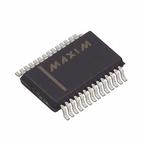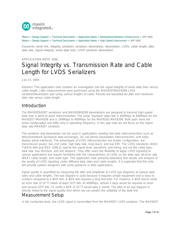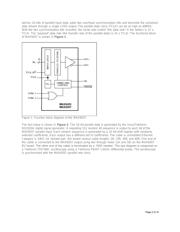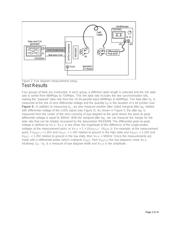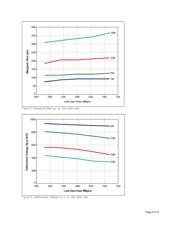herunterladen

Maxim > Design Support > Technical Documents > Application Notes > Basestations/Wireless Infrastructure > APP 1856
Maxim > Design Support > Technical Documents > Application Notes > High-Speed Interconnect > APP 1856
Keywords: serial link, integrity, serializer, serialiser, deserializer, deserialiser, LVDS, cable length, jitter,
data rate, signal integrity, serial data links, LVDS serializer deserializer
APPLICATION NOTE 1856
Signal Integrity vs. Transmission Rate and Cable
Length for LVDS Serializers
Jan 17, 2003
Abstract: This application note contains an investigation into the signal integrity of serial data links versus
cable length. Jitter measurements were performed using the MAX9207/MAX9208 LVDS
serializer/deserializer pair using various lengths of cable. Results are tabulated for jitter and maximum
data rate versus cable length.
Introduction
The MAX9205/9207 serializers and MAX9206/9208 deserializers are designed to transmit high-speed
data over a point-to-point interconnection. The serial "payload" data rate is 400Mbps to 600Mbps for the
MAX9207-MAX9208 and is 160Mbps to 400Mbps for the MAX9205-MAX9206. Both pairs have the
same configuration and differ only in operating frequency. In this app note we will focus on the higher
data rate MAX9207 serializer.
The serializer and deserializer can be used in applications needing fast data interconnections such as
telecom/network backplane data exchanges, 3G cell phone basestation interconnection, and video
display panel interfaces. The advantages of LVDS interconnection are simple configuration, low
transmission power, low cost cable, high data rate, long reach, and low EMI. The LVDS standards (ANSI
TIA/EIA-644 and IEEE 1596.3) specify the signal level, waveform, and timing, but not the cable type,
data rate, bus structure, and link distance. They offer users the flexibility to apply LVDS signaling to
various applications but require familiarity with the characteristics of LVDS on the data rate, bit error rate
(BER), cable length, and cable type. This application note presents laboratory test results and analysis of
the quality of LVDS signaling under different data rates and cable lengths. It is expected that this note
will provide system designers with some guidance in their applications.
Signal quality is quantified by measuring the jitter and amplitude of LVDS eye diagrams at various date
rates and cable lengths. The eye diagram is used because it requires simple equipment and is easy to
conduct compared to a BER test. A BER test requires a long test time. For instance, a BER test to verify
an error rate of 10
-12
needs at least 10
14
bits. At 400Mbps, almost 3 days would be required to send
and receive 10
14
bits. To verify a BER of 10
-13
would take a month. The jitter of an eye diagram is
directly linked to the signal quality from which we can predict the reliability of the data link.
Measurement Setup
In the conducted tests, the LVDS signal is transmitted from the MAX9207 LVDS serializer. The MAX9207
Page 1 of 10

